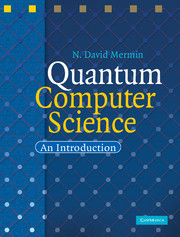Book contents
- Frontmatter
- Contents
- Preface
- A note on references
- 1 Cbits and Qbits
- 2 General features and some simple examples
- 3 Breaking RSA encryption
- 4 Searching with a quantum computer
- 5 Quantum error correction
- 6 Protocols that use just a few Qbits
- Appendices
- A Vector spaces: basic properties and Dirac notation
- B Structure of the general 1-Qbit unitary transformation
- C Structure of the general 1-Qbit state
- D Spooky action at a distance
- E Consistency of the generalized Born rule
- F Other aspects of Deutsch's problem
- G The probability of success in Simon's problem
- H One way to make a cNOT gate
- I A little elementary group theory
- J Some simple number theory
- K Period finding and continued fractions
- L Better estimates of success in period finding
- M Factoring and period finding
- N Shor's 9-Qbit error-correcting code
- O A circuit-diagrammatic treatment of the 7-Qbit code
- P On bit commitment
- Index
K - Period finding and continued fractions
from Appendices
Published online by Cambridge University Press: 05 June 2012
- Frontmatter
- Contents
- Preface
- A note on references
- 1 Cbits and Qbits
- 2 General features and some simple examples
- 3 Breaking RSA encryption
- 4 Searching with a quantum computer
- 5 Quantum error correction
- 6 Protocols that use just a few Qbits
- Appendices
- A Vector spaces: basic properties and Dirac notation
- B Structure of the general 1-Qbit unitary transformation
- C Structure of the general 1-Qbit state
- D Spooky action at a distance
- E Consistency of the generalized Born rule
- F Other aspects of Deutsch's problem
- G The probability of success in Simon's problem
- H One way to make a cNOT gate
- I A little elementary group theory
- J Some simple number theory
- K Period finding and continued fractions
- L Better estimates of success in period finding
- M Factoring and period finding
- N Shor's 9-Qbit error-correcting code
- O A circuit-diagrammatic treatment of the 7-Qbit code
- P On bit commitment
- Index
Summary
We illustrate here the mathematics of the final (post-quantum-computational) stage of Shor's period-finding procedure. The final measurement produces (with high probability) an integer y that is within ½ of an integral multiple of 2n/r, where n is the number of Qbits in the input register, satisfying 2n > N2 > r2. Deducing the period r of the function f from such an integer y makes use of the theorem that if x is an estimate for the fraction j/r that differs from it by less than ½r2, then j/r will appear as one of the partial sums in the continued-fraction expansion of x. In the case of Shor's period finding algorithm x = y/2n. If j and r happen to have no factors in common, r is given by the denominator of the partial sum with the largest denominator less than N. Otherwise the continued-fraction expansion of x gives r0: r divided by whatever factor it has in common with the random integer j. If several small multiples of r0 fail to be a period of f, one repeats the whole procedure, getting a different submultiple r1 of r. There is a good chance that r will be the least common multiple of r0 and r1, or a not terribly large multiple of it. If not, one repeats the whole procedure a few more times until one succeeds in finding a period of f.
- Type
- Chapter
- Information
- Quantum Computer ScienceAn Introduction, pp. 197 - 200Publisher: Cambridge University PressPrint publication year: 2007



